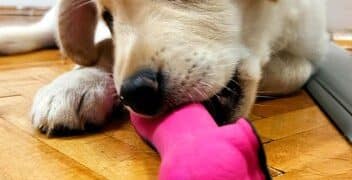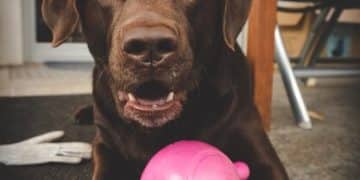Stop Dog Chewing: 3 Steps to Redirect Destructive Habits
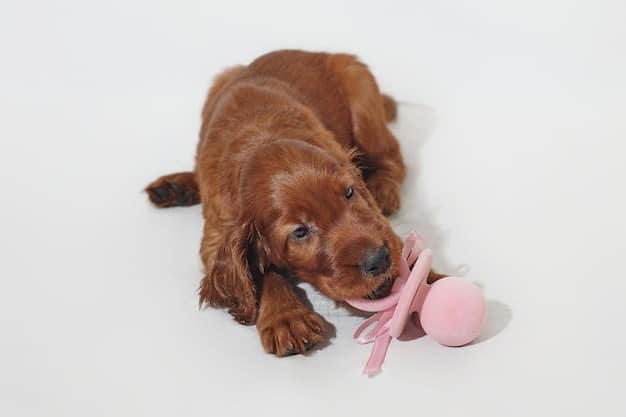
Redirecting your dog’s destructive chewing habits involves understanding the reasons behind the behavior, providing appropriate chew toys, and implementing consistent training techniques to ensure a happy and undamaged home environment.
Is your furniture falling victim to your furry friend’s teeth? Let’s decode the reasons behind this behavior and explore actionable steps to redirect your dog’s destructive chewing habits.
Chewing Destruction SOS: Understanding Why Dogs Chew
Chewing is a perfectly normal and natural behavior for dogs. However, when it becomes destructive, it’s time to intervene. Understanding why dogs chew is the first step in effectively redirecting this behavior. There are several underlying reasons for chewing, ranging from puppyhood teething to anxiety.
Puppy Teething
Puppies go through a teething phase much like human babies. During this time, their gums are sore and inflamed, making them want to gnaw on anything they can get their paws on. This is typically a temporary phase that lasts a few months.
Boredom and Lack of Stimulation
Dogs are intelligent creatures who require mental and physical stimulation. If left alone for extended periods without anything to occupy them, they might turn to chewing out of boredom. This is especially true for high-energy breeds like Border Collies or Huskies.
Anxiety and Stress
Chewing can also be a coping mechanism for dogs experiencing anxiety or stress. Separation anxiety, loud noises, or changes in their environment can all trigger this behavior. In these cases, chewing acts as a self-soothing activity.
- Teething Relief: Provide puppies with safe and appropriate chew toys to alleviate gum pain.
- Mental Stimulation: Engage your dog in regular activities such as walks, training sessions, and puzzle toys to prevent boredom.
- Anxiety Management: Create a calm and stable environment for your dog, and consider consulting a veterinarian or behaviorist for severe anxiety.
Understanding these underlying causes is crucial for developing an effective strategy to manage and redirect your dog’s chewing habits. Knowing the “why” helps you address the problem at its root.
Step 1: Provide Appropriate Chew Toys
One of the most effective ways to redirect a dog’s chewing habits is by providing a variety of appropriate chew toys. These toys should be safe, durable, and appealing to your dog.
Types of Chew Toys
There are numerous types of chew toys available on the market, each with its own benefits. It’s essential to select toys that are suitable for your dog’s age, size, and chewing style. Rotate toys regularly to keep your dog interested.
Safety First
Always prioritize safety when selecting chew toys. Avoid toys that can easily be torn apart and ingested, as these can pose a choking hazard or cause intestinal blockages. Inspect toys regularly for damage and replace them when necessary.
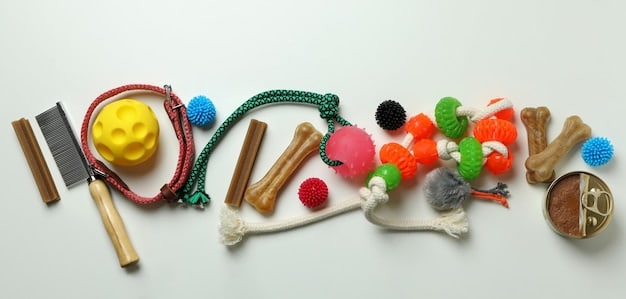
- Rubber Toys: Durable rubber toys like Kongs can be stuffed with treats or peanut butter to keep your dog engaged for hours.
- Rope Toys: Rope toys are great for dental health and can withstand moderate chewing.
- Puzzle Toys: These toys challenge your dog mentally and physically, making them an excellent option for high-energy breeds.
By offering a variety of safe and engaging chew toys, you can provide your dog with a positive outlet for their chewing instincts, reducing the likelihood of them turning to your furniture or other inappropriate items.
Step 2: Implement Consistent Training
Training is crucial for redirecting your dog’s chewing habits. Consistent commands and positive reinforcement can teach your dog what is acceptable to chew and what is not.
The “Leave It” Command
The “leave it” command is an invaluable tool for preventing your dog from chewing on prohibited items. Start by placing a treat on the floor and covering it with your hand. When your dog tries to get the treat, say “leave it.” Once they stop, reward them with a different treat from your other hand.
Positive Reinforcement
Positive reinforcement involves rewarding your dog for good behavior. When you catch your dog chewing on an appropriate toy, praise them and offer a treat. This reinforces the idea that chewing on their toys is a positive and rewarding activity.
Consistency is Key
Consistency is essential for successful training. Everyone in the household should use the same commands and reinforcement methods. This will help your dog understand what is expected of them and prevent confusion.
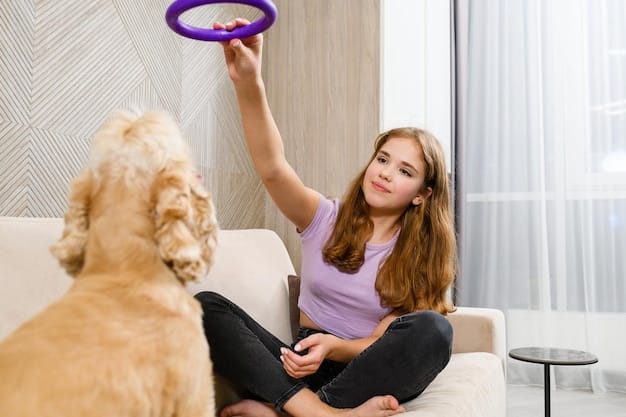
- Start Early: Begin training your dog as early as possible to establish good habits.
- Keep it Positive: Use positive reinforcement techniques to motivate your dog and create a positive association with training.
- Be Patient: Training takes time and patience. Don’t get discouraged if your dog doesn’t understand the commands immediately.
By implementing consistent training techniques, you can teach your dog to make appropriate chewing choices and prevent destructive behavior.
Step 3: Manage the Environment
Managing your dog’s environment is a crucial part of redirecting destructive chewing habits. This involves removing temptations, creating a safe space, and providing plenty of supervision.
Remove Temptations
The first step in managing the environment is to remove any items that your dog might be tempted to chew on. This includes shoes, books, remote controls, and anything else that they might find appealing. Store these items out of reach or in a secure location.
Create a Safe Space
Providing your dog with a safe and comfortable space can help reduce anxiety and prevent destructive chewing. This space could be a crate, a bed, or a designated area in your home where they feel secure and relaxed.
Supervision and Redirection
Supervision is essential, especially during the initial stages of training. When you are unable to supervise your dog, consider confining them to a crate or a safe area. If you catch your dog chewing on something they shouldn’t, redirect them to an appropriate chew toy.
- Dog-Proof Your Home: Remove or secure any items that could be harmful or tempting to your dog.
- Provide a Comfortable Retreat: Create a safe and secure space where your dog can relax and feel comfortable.
- Consistent Monitoring: Keep a close eye on your dog, especially when they are unsupervised, to prevent destructive chewing.
By managing your dog’s environment, you can minimize the opportunities for destructive chewing and create a more positive and safe environment for both you and your furry friend.
Addressing Specific Chewing Issues
While the previous steps provide a comprehensive approach to redirecting chewing habits, some dogs may exhibit specific issues that require additional attention. Addressing these issues can further improve your dog’s behavior and overall well-being.
Chewing Out of Separation Anxiety
If your dog chews primarily when left alone, separation anxiety may be the culprit. This can manifest as excessive barking, pacing, and destructive behavior, often focused on areas near doors and windows. Consulting a veterinarian or a certified dog behaviorist is advisable.
Dietary Deficiencies
In rare cases, destructive chewing may be linked to dietary deficiencies. A well-balanced diet is crucial for your dog’s overall health and well-being. Consult your veterinarian to ensure that your dog’s nutritional needs are being met.
Seeking Professional Help
If you are struggling to manage your dog’s chewing habits on your own, don’t hesitate to seek professional help. A certified dog trainer or behaviorist can provide valuable guidance and support.
- Professional Assessment: A behaviorist can assess your dog’s chewing habits and develop a tailored plan.
- Medication: In some cases, medication may be necessary to manage anxiety or other underlying issues.
- Long-Term Support: Professional guidance can provide you with strategies to manage your dog’s behavior in the long term.
Addressing specific chewing issues requires a comprehensive approach that considers your dog’s individual needs and circumstances.
Maintaining Long-Term Success
Redirecting a dog’s chewing habits is an ongoing process that requires patience, consistency, and dedication. To ensure long-term success, it’s essential to maintain the strategies and techniques that have proven effective.
Continued Training and Enrichment
Continue to reinforce the training commands you’ve taught your dog and provide them with plenty of mental and physical enrichment. This will help keep them engaged and prevent boredom-related chewing.
Regular Veterinary Check-Ups
Regular veterinary check-ups are crucial for monitoring your dog’s overall health and identifying any underlying issues that could be contributing to their chewing habits. Your veterinarian can provide valuable guidance and support.
Adapting to Changes
Be prepared to adapt your strategies as your dog’s needs change over time. As they age, their chewing habits may evolve, requiring adjustments to their toys, training, and environment.
- Lifelong Learning: Never stop reinforcing good behavior and providing mental stimulation.
- Health Monitoring: Keep up with veterinary visits to ensure your dog’s physical and mental health are in good condition.
- Flexible Approach: Be receptive to altering your strategies as your dog develops through various life stages.
Sustaining long-term success in managing your dog’s chewing requires continuous care, vigilance, and willingness to change your approach as the need arises. Stay engaged in their overall well-being and adjust your approaches along the way.
| Key Point | Brief Description |
|---|---|
| 🦴 Appropriate Toys | Offer a variety of safe chew toys to redirect chewing. |
| 🐾 Consistent Training | Use “leave it” command and positive reinforcement. |
| 🏡 Manage Environment | Remove temptations and create a safe space. |
| 🩺 Seek Professional Help | Consult a trainer for persistent issues. |
FAQ
▼
A sudden increase in chewing can indicate anxiety, boredom, or a change in environment. It could also point to a medical issue causing discomfort, prompting the dog to self-soothe through chewing.
▼
Durable rubber toys, rope toys, and puzzle toys filled with treats are excellent alternatives. Always supervise your dog with new toys to ensure they are safe and cannot be easily destroyed and ingested.
▼
Inspect chew toys regularly for damage and replace them as soon as they show signs of wear and tear. The frequency depends on your dog’s chewing intensity, but generally, every few weeks is a good guideline.
▼
Yes, excessive chewing can sometimes indicate a dental problem, gastrointestinal issue, or other health concerns. If the behavior is sudden or accompanied by other symptoms, consult your veterinarian for an evaluation.
▼
Boredom chewing usually occurs when the dog is alone and has nothing else to do. Anxious chewing may be accompanied by other signs like pacing, panting, and destructive behavior aimed at escape, such as door frames.
Conclusion
Redirecting your dog’s destructive chewing habits using these three steps – providing appropriate chew toys, implementing consistent training, and managing the environment – is possible with patience and perseverance. Understanding the root causes of chewing, tailoring your approach to your dog’s specific needs, and seeking professional help when necessary will pave the way for a harmonious, chew-free home.
